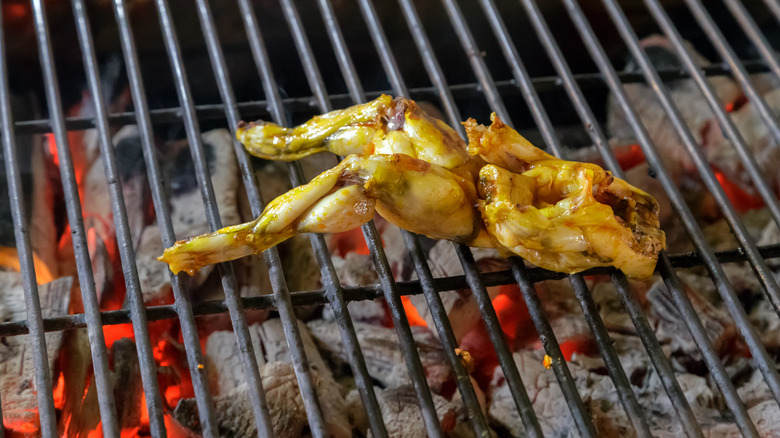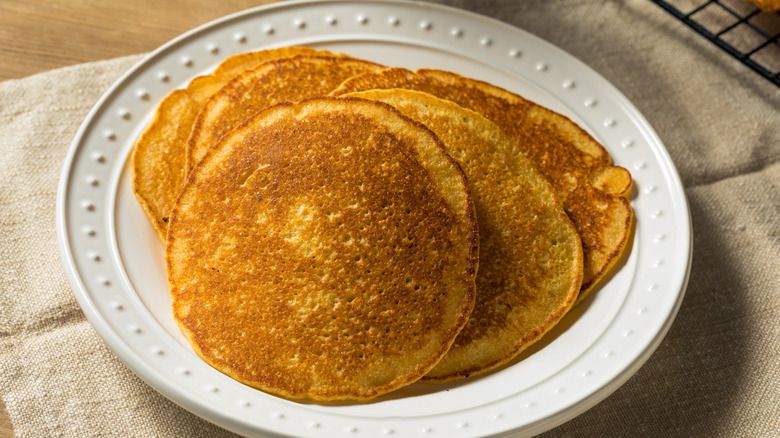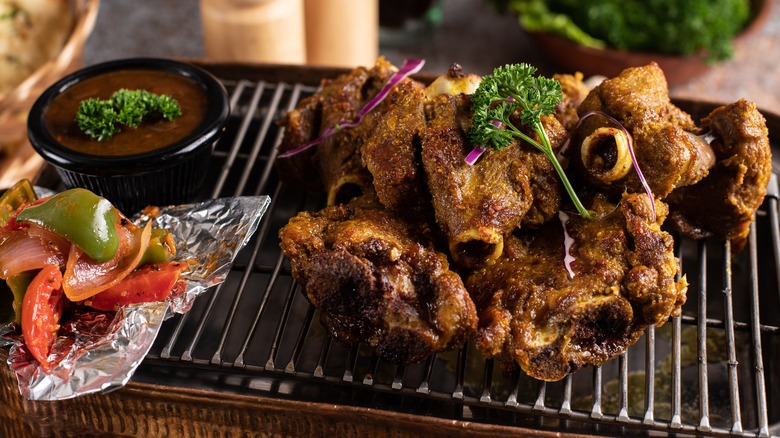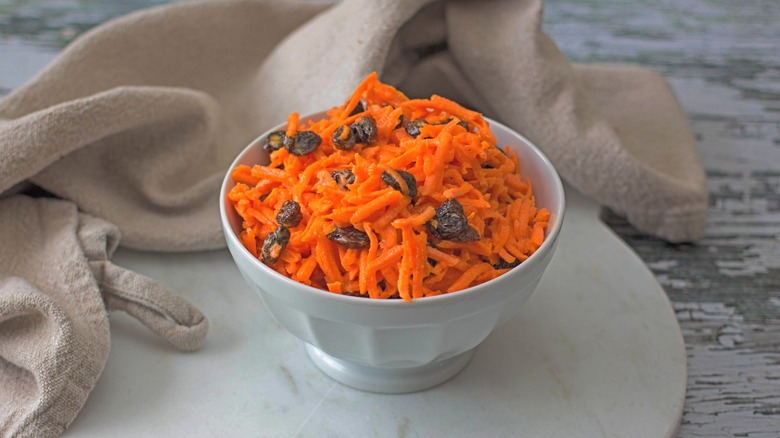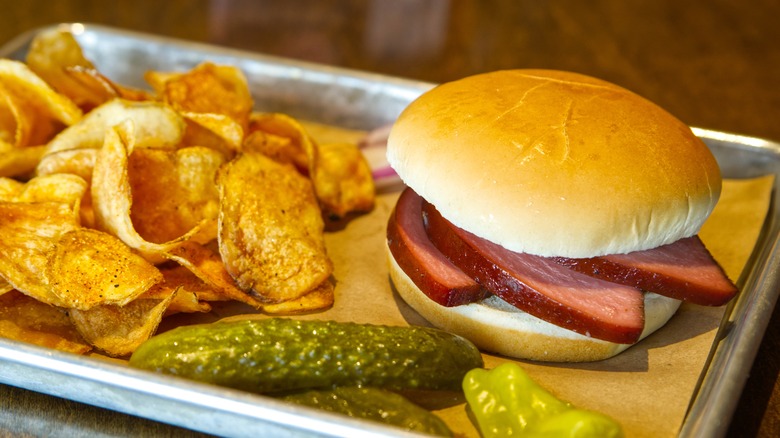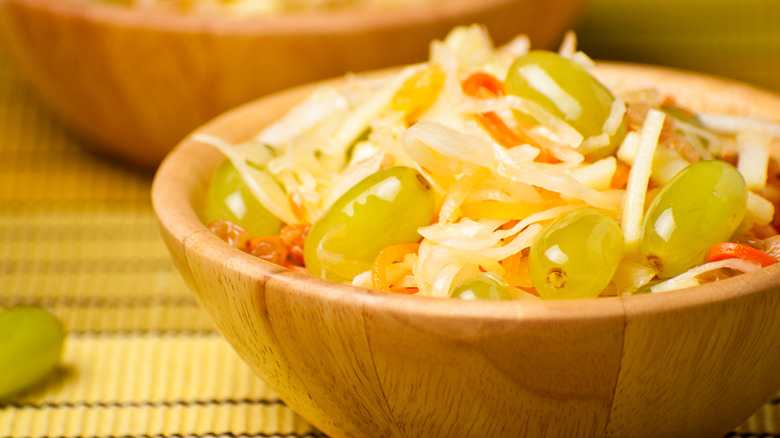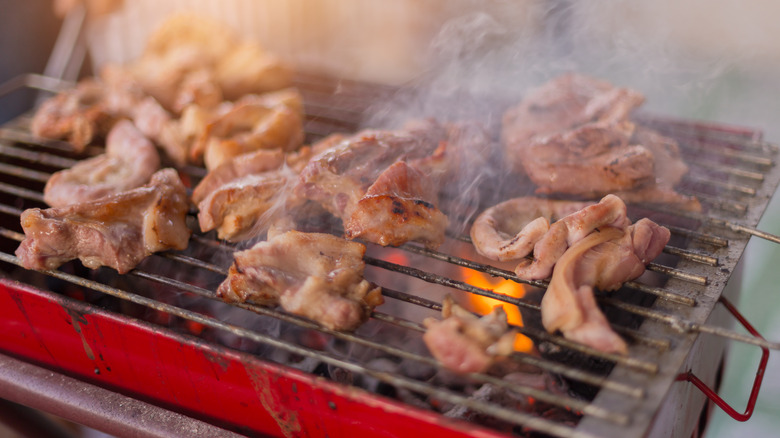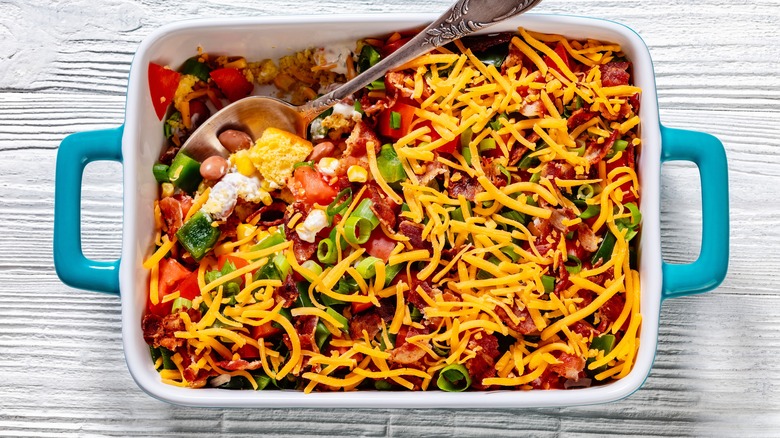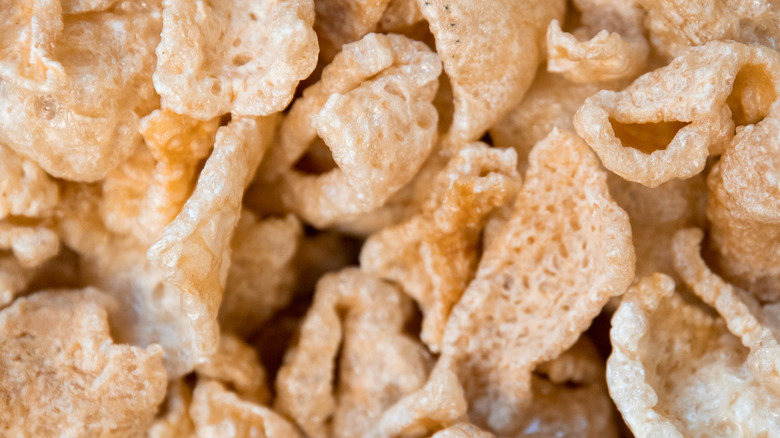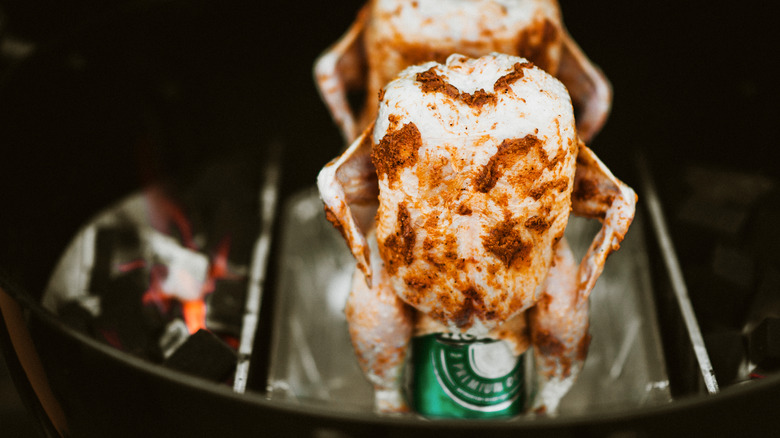Old School BBQ Dishes Nearly Everyone Forgot About
Barbecue holds a long history in the United States — one much vaster than most people are aware. Although some might believe barbecue to be an American invention considering its strong association with the 4th of July and other patriotic holidays, its roots are far more diverse. While cooking meat over a fire is a prehistoric tradition, barbecue as we know it actually originates from Caribbean culture, where meats were cooked long and slow over green wood to prevent burning.
Barbacoa, as it was called in Spanish, was brought to the Americas by Spanish explorers who landed in the Caribbean before bringing the practice to America. It is believed the first barbecue gathering in this country occurred in 1540 between Hernando de Soto and the indigenous people, when the two groups feasted together in what is today known as Mississippi. Obviously, barbecue has come a long way since then, with diverse regional styles emerging all across the U.S.
Over the years, recipes have evolved, as well, with certain dishes falling in and out of favor. While some classic dishes have remained firmly entrenched, like potato salad and hush puppies, others have faded into the distance, nearly lost to time within the yellowing pages of old cookbooks. It's time to explore the barbecue dishes of yesteryear and decide whether or not these retro recipes deserve a revival.
Corn pudding
Corn pudding was a summer classic that originated in the South, often making the rounds at holidays, summer potlucks, and barbecues. Made from corn bread, canned corn, and dairy, its sweet and savory flavor pairs perfectly with items like fried chicken or brisket. Although most classic recipes include baking the tasty creation in a casserole pan, it can also be baked in cast iron to give it a golden-crisp crust on the edges, while the center stays rich and soft.
Luckily, this traditional dish has not been forgotten, with some home cooks still holding old recipes that have since become a Thanksgiving day classic in many households. This classic barbecue pairing is fashioned from both creamed corn and whole kernel style canned corn, mixed with butter, dry cornbread mix, and sour cream, although some recipes also use eggs or heavy cream. Once baked, the result is a delightfully warm blend of cornbread and casserole, perfect for slathering with spicy honey. Contemporary takes on the dish have added new elements, like jalapeños and cheddar cheese, modernizing the recipe for current palates.
Barbecued frog legs
It may seem strange today, but frog legs used to be a frequent barbecue item in areas like Louisiana. Hunting and harvesting frogs, also known as frogging, was a traditional pastime for many families in the South. If lucky, the venture would end in a bounty of frog legs for dinner. Although many old recipes were for fried frog legs, you'll also find ones in which these ribbety bits were slathered in BBQ sauce and grilled.
It is interesting to note that although this dish is today associated with Southern cuisine, eating frog legs as a food staple dates back far earlier. Frog legs were regular fare in southern China and Aztec culture, later garnering popularity in France, where they became a delicacy. Fortunately, the dish is still popular in the U.S. in certain communities. Hoping to try this dish yourself? You can do so in Fellsmere, Florida, where the Fellsmere Frog Leg Festival takes place every year.
Hoe cakes
These simple, unleavened delights are like cornbread, but far more dressed down. Made from cornmeal, salt, and water, these dense rounds were considered the perfect platter on which to stack other BBQ sides like greens and corn. Although they may resemble pancakes, they are vastly different. The batter is thicker and far less sweet, similar to traditional Southern cornbread, with the end result being far hardier. These golden-fried, flat cakes are perfect when paired with savory ingredients, like pulled pork sandwiches smeared with creamy slaw.
The name was once rumored to have come from enslaved individuals cooking these cakes on field hoes, and is likely more mythos than reality. Others believe it may be sourced to the device used to cook the cakes, with the word hoe once being a common word for a griddle. Today, the simple cakes are fried in everything from peanut oil to bacon fat, ensuring this no-nonsense barbecue sides stays on the table for generations to come.
Barbecued mutton
Now a difficult-to-find dish outside of certain regions, barbecued mutton was once a frequent protein in the barbecue world. Different from lamb, which is less than one year of age when butchered, mutton refers to sheep aged one to three years. Once quite popular, smoked mutton is now considered a dish distinctive to Kentucky barbecue. The smoking method tenderizes this less tender meat, rendering it soft enough to fall off the bone with ease. It can then be served chopped or shredded and smothered with sauce.
However, you're unlikely to find this dish today unless you know a sheep farmer. In the United States, mutton fell out of fashion after WWII, with meats requiring less laborious cooking methods replacing it. Being a tougher meat, mutton required cooking in the "low and slow" approach. Additionally, after many soldiers returned home from abroad having survived on canned mutton, the meat quickly lost its appeal. Alongside the decrease of wool production in the U.S. the dish soon vanished from menus.
Today, it is extremely difficult to acquire mutton in the United States, since it costs more to raise sheep to this age and there is little demand for this meat. Traditionally slow-roasted over hickory wood in a pit, this smoky meat can still be found in some locations within Kentucky, where cities like Owensboro continue to keep the tradition alive. To those intent on sampling this elusive meat, you may be interested in Owenboro's International Bar-B-Q Festival, held every May.
Carrot raisin salad
Once a common BBQ side dish rarely seen anymore, carrot raisin salad is missed by few and far between. Assembled from shredded carrots, mayonnaise, lemon juice, and raisins, this earthy side dish used to be a staple at many a cookout for potluck. While it's difficult to pinpoint why this dish fell out of fashion, it is likely due to shifting tastes in salad preferences, loosing its appeal along with gelatinized salads like the similarly-flavored carrot and pineapple jello salad, which were once popular around the same time.
Once trendy enough to be a mainstay at Chick-fil-A for 40 years, the dish departed the menu of this Georgia-born fast food chain in 2013, although it can still be found in the brand's home city of Atlanta at Truett's Grill and the Dwarf House. The recipe, since released on the website along with the discontinued coleslaw recipe, includes canned pineapple and more than ½ cup of sugar.
Smoked bologna
Known to be a trademark of Oklahoma barbecue to this day, smoked bologna has long been a barbecue tradition in the Sooner state, where it is fondly referred to as "Oklahoma steak." Others who grew up on the dish call it "Oklahoma prime rib" or "Oklahoma tenderloin," suggesting the esteem many held for the classic offering.
Although relatively unheard of outside of the region, the dish shows up everywhere in Oklahoma, from backyard barbecues to high-end restaurants and steakhouses. Many suspect the dish became popular in the area because the meat was inexpensive, making it a thrifty way to feed an entire family. Regardless of its origins, it's a dish that is known to be a staple in the dustbowl state.
Why is it so popular? It's more than just childhood nostalgia. The barbecue flavor has a unique way of soaking into this sausage meat, imbuing it with a certain smokiness. This makes it great on its own or in sandwiches. In Oklahoma, restaurants that still serve this barbecue classic tend to smoke it over hickory or pecan wood, lending the meat plenty of flavor to serve along with other hearty BBQ sides and meats.
Fruit slaw
While many of us still enjoy a nice cabbage-based coleslaw to this day, few add quite as many fruits to the mix as those attending old-school barbecues once did. Old-fashioned coleslaw recipes often included elements like mandarin oranges, chopped apples, grapes, and raisins in addition to the usual cabbage and mayo. You'll also see vintage recipes including elements like pineapple, peaches, and even marshmallows mixed with celery and apple.
Why the shift? The history of coleslaw is an interesting one. In the early 20th century, most recipes consisted of a straightforward mixture of chopped cabbage, with a vinegar-based dressing including no more than sugar, salt and pepper, egg, and cream. Yet by the 1930s, the recipes began to get more creative, introducing fruit, other vegetables, and various dressings to the mix. In the '40s, shredded carrots began showing up in recipes. In the '50s, dishes including gelatinized mustard made their way into cookbooks.
By the '70s, raisins had entered the picture, sometimes calling to be soaked in orange juice. In the '80s, fresh green grapes seemed to replace dried raisins. Recipes over the years have also included everything from mint leaves to poppy seeds, proving that this dish is barbecue staple with many incarnations.
Barbecued goat ribs
Long before beef and pork were popular barbecue meats, goat was a frequent protein to hit the flames. This leaner meat was best cooked low and slow, absorbing all the smoky goodness akin to a great barbecue course. Particularly popular in the Western United States due to Mexican influence, common cuts usually included goat ribs, goat legs, or shoulder meat.
Legs and shoulder cuts are spectacular for slow-cooked barbecue, while loins and ribs make for more tender fare, like kebabs. Cooking the protein at a low temperature helps this leaner meat to soak up all the smokiness inherent in barbecued cuisine, leaving the meat soft and tender. Today, people expect more fat in their barbecued meats, often turning to beef and pork instead. Meats like goat and lamb are leaner, and, as some might claim, gamier in flavor.
Still, the meat hasn't completely vanished from barbecue in certain cultures. There's a lengthy history of eating goat meat or cabrito in Mexican culture, particularly in Hidalgo. Goat has also been widely consumed in Caribbean, Middle Eastern, and African cultures. Occasionally you'll still find restaurants offering goat in Texas, along with old-fashioned recipes for barbecued goat ribs, although the dish has become somewhat of a rarity today.
Chitlins
Pig intestines, also called chitlins or chitterlings, were often included within the large spread at cookouts and barbecues in the rural South, usually accompanying items like collard greens and fried chicken. Historically cooked outside due to their strong aroma, these innards were common in BBQ culture for years, especially in African American communities.
The popularity of this dish in such communities likely rose out of West African cooking traditions, in which all edible portions of the animal were cooked and consumed. Items like pig ears, intestines, and pig feet were items often discarded by others, leaving them available for more industrious folk. Although still consumed around the holidays in rural communities, the dish is far less common than it once was at barbecues in the modern era.
Part of the reason these items may have fallen out of favor is the substantial work required to prepare them. These less-commonly seen barbecue items require a good deal of work before cooking. Although partway cleaned when purchased, they call for a more intensive cleaning by hand before boiling and frying to remove the foreign matter from the intestines.
Cornbread salad
Cornbread salad is a fantastic old-school barbecue dish usually served chilled. Often layered with corn, cheese, veggies, bacon, and crumbled pieces of cornbread, it's basically a Southern version of seven layer dip, but with more mayo. The cornbread is first baked, then cooled and crumbled, acting as the bedrock for this striking side dish. A dressing is often made next, frequently with sour cream, mayonnaise, and ranch seasoning. Then, various layers are added, and the dish is refrigerated overnight.
Likely popular since it could be made with whatever fresh summer vegetables were available in one's garden blended with a solid amount of canned pantry staples, the dish seems to be one with a good deal of staying power. Although it may sound odd, the appearance of this dish can actually be quite stunning when placed in a glass trifle dish. Perfect for potluck and summer get-togethers, the food is both filling and refreshing due to its chilled nature, arguably making it one of those lesser-seen barbecue dishes deserving of a comeback.
Fried okra and collard greens
A summer necessity at many cookouts, okra often made the rounds at barbecues and outdoor gatherings in the warmer months, as this was when the green was in peak season. Okra is a seed pod that can be grilled, boiled in gumbo, or even pickled, but frying is arguably the best of all when it comes to old-fashioned barbecues, since frying helps to temper the sliminess that this veggie can acquire when sliced.
Recipes include chopping up the seed pods when they are young and more tender, then coating them in a cornbread and flour mixture before quickly frying in hot oil. Big in the South, this breaded side is often offered alongside other barbecue favorites like collard greens and smoked meats.
Collard greens are another once-common side, still popular in the South and in soul food, but rarely seen outside of the region. Similar to okra, this plant was one that flourished in poor soil and high temperatures, making it ideal for growing in the American South. The tough green is prepared by stewing the leaves with meat so they become soft and flavorful. Their earthy flavor makes a perfect complement to barbecue dishes like brisket and ribs.
Pork cracklins
Also known as fried pig skin, cracklins are hard to find these days in their authentic form. This crunchy delight was often a byproduct of processing a whole hog — a task that often took place between Thanksgiving and Christmas in the South — but soon found its way into barbecue culture as a crispy topping.
Like pork rinds, but with more fat, cracklins are created by rendering the excess potions off the pig (including fat and other leftover bits), which were cooked down in large pots. These scraps of fried skin would then rise to the top of the medley. Once salted, they often acted as the perfect snack or topping for other items, like hot dogs.
Interestingly, pork rinds and cracklins received a comeback not too long ago with the increase of low carb diets. Served with items like pulled pork and other classic barbecue sides, the salty, crunchy treat lends a sensational contrast in texture along with a boost of flavor. This item still remains a popular snack in Mexico, Columbia, Brazil, and the Philippines, where they are sometimes called chicharrones.
Black-eyed pea salad
Called Texas caviar or cowboy caviar by some, black-eyed pea salad was once a common side dish at barbecues that has experienced a small resurgence recently, thanks to TikTok. This summer-time dish is usually fashioned from black-eyed peas, along with diced tomatoes, onions, and peppers. Although some credit the invention of the dish to the 1940s, black-eyed peas have been served with greens and cornbread long before this, dating back to the time of the Civil War.
Believed to have been brought to America by enslaved people brought here from Africa, black-eyed peas have remained a staple of barbecue culture and soul food. In fact, many Africa Americans ate boiled black eyed peas as a celebratory meal on the first of January, 1863 when the Emancipation Proclamation went into effect establishing thousands as free citizens. Later dishes went on to include black-eyed peas in new and intriguing ways, keeping the heritage of this food alive.
While classic recipes for this bean salad usually just included more pared down ingredients, more recent takes on the classic dish have included adding new elements like mango, avocado, feta cheese, and jalapeños. Now frequently served as a side for dipping chips into, the chilled dish is a wonderful accompaniment for other barbecue dishes, providing a refreshing and cool bite to break up meatier plates.
Beer can chicken
Beer can chicken is a hotly contested item in the barbecue community. This controversial culinary method involves cooking a whole chicken carefully placed atop an open beer can on a hot grill in the hopes that the steaming beer will flavor the bird. Proponents of this barbecue dish swear it to be one of the best methods to yield an especially moist and tender chicken, while others believe the invention is more theatrics than science, leading to a lower-quality product.
Many argue that the beer does little to flavor the chicken, and placing a metal can inside the bird can potentially interfere with the cooking process. Because the can blocks the cavity, it makes it harder for heat to enter the interior. As a result, you're only cooking the chicken on one side, making you more likely to overcook the dish.
Still, you'll find plenty of die-hard enthusiasts who swear otherwise, proclaiming this chicken cooking technique to be superior to all others. All things considered, there's little harm in testing out this zany barbecue recipe to those intrigued by the proposition — you can even substitute Coca-Cola for beer if you so desire. As long as you serve the dish with plenty of classic barbecue sides, your guests are unlikely to complain.



